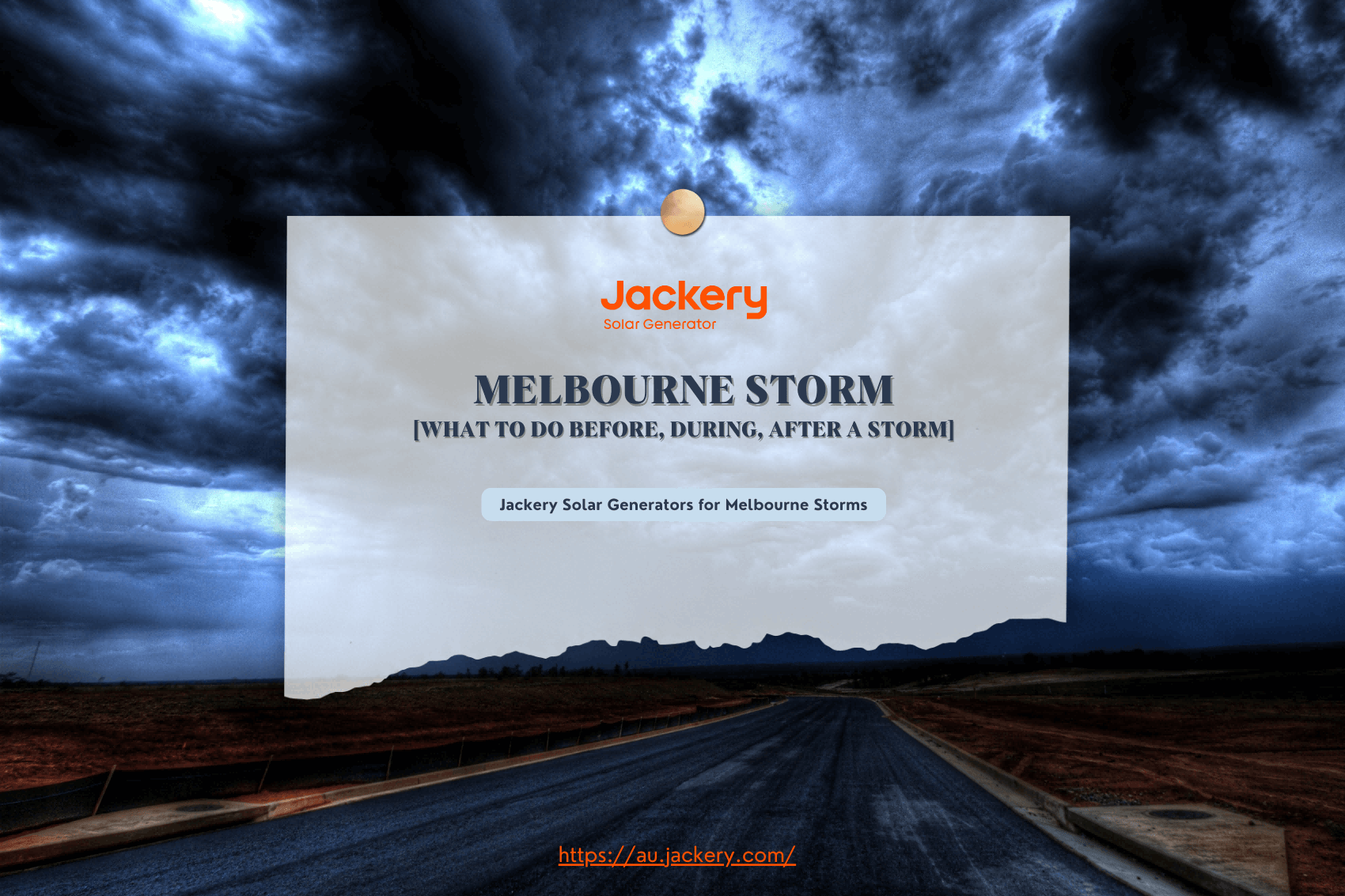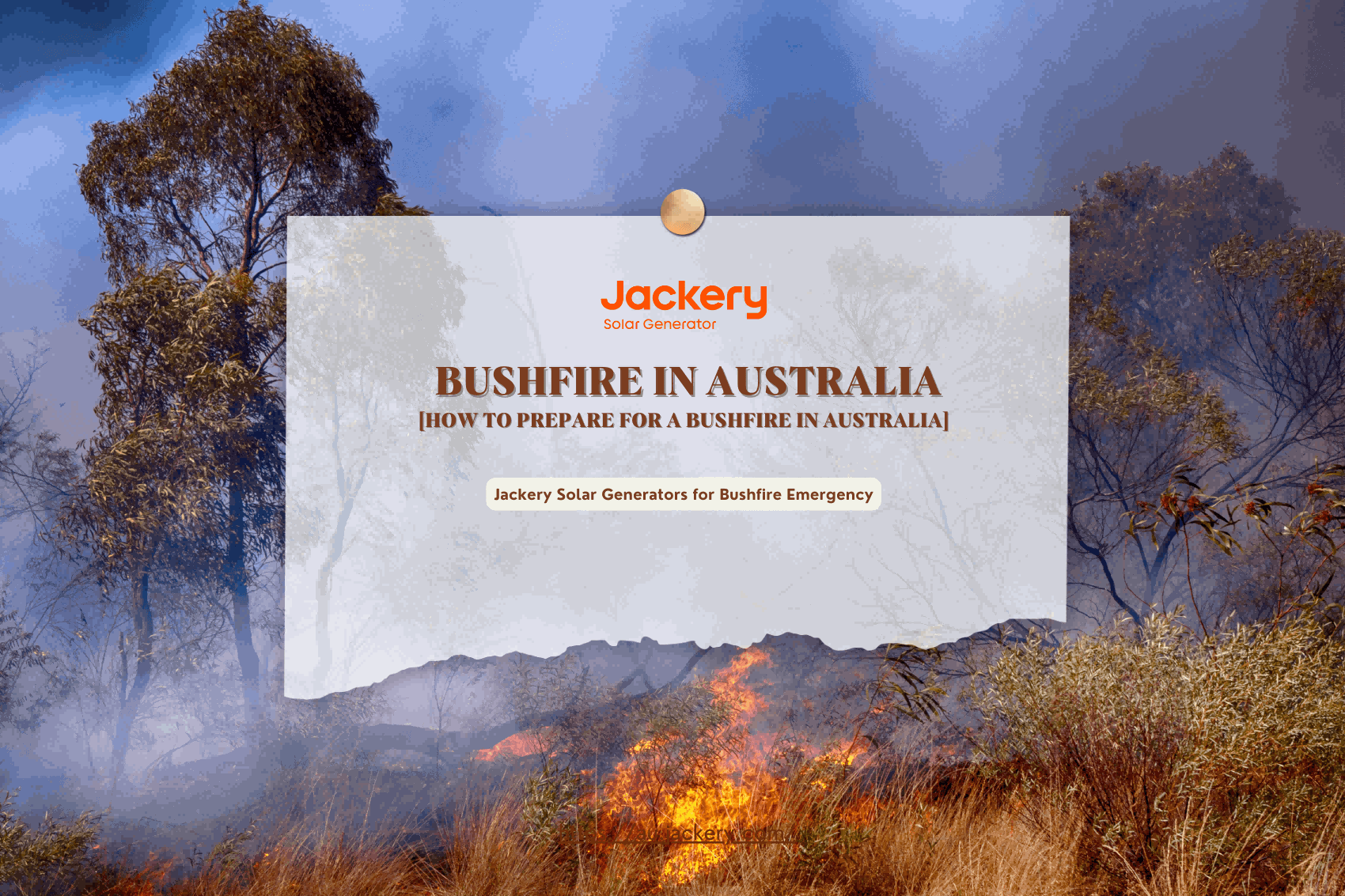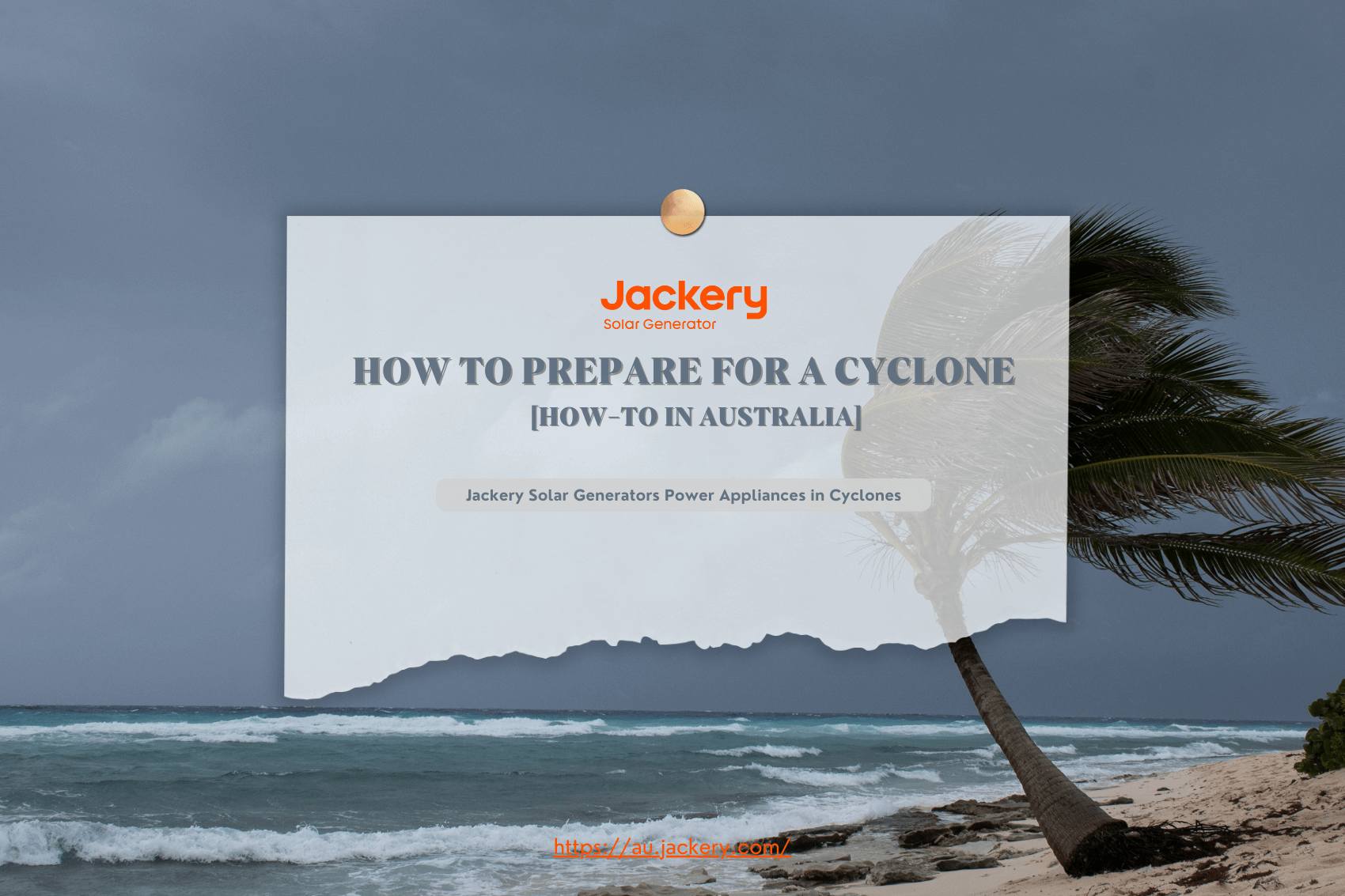|
Key Takeaways: |
|
• The Melbourne storm is a severe meteorological event marked by strong winds, heavy precipitation, thunder and lightning and is frequently accompanied by additional phenomena such as hail or tornadoes. • Residents in storm-prone areas must go beyond immediate storm preparations and consider long-term solutions to avoid post-storm damage. There are six steps to prepare for a storm in Melbourne: storm prediction, understanding storm warnings, securing your home, packing an emergency kit, and taking action for your pets. • Jackery Solar Generators are a safe and practical choice for storm electrical solutions. We highly recommend Jackery Solar Generator 1000 Pro and 500 to charge your essential electronics before or during a storm. • During a storm, you should consider three scenarios - when you are at home, in a public area, and driving, and take relative actions for different situations. • It is necessary to assess safety hazards, check everything, clean up debris, and learn from experience after a storm. |
What Is Melbourne Storm?
The Melbourne storm is a severe meteorological event marked by strong winds, heavy precipitation, thunder and lightning and is frequently accompanied by additional phenomena such as hail or tornadoes.
Storms form due to significant atmospheric disturbances, frequently fueled by temperature differences and environmental instability. Storm development usually includes the following key elements:
- Moisture: A storm requires sufficient moisture at the lower layers of the atmosphere. Moisture is essential since it feeds the storm system and helps generate clouds and precipitation.
- Rising Warm Air: A storm will likely form when humid, warm air rises into the cooler air above. As air rises, it cools and condenses into water droplets or ice crystals, resulting in clouds. This process releases latent heat, which provides energy to the storm system.
- Instability in the Atmosphere: Atmospheric instability traps warm air beneath cooler air, causing it to rise quickly. This instability is a driving force in the production of thunderstorms.
- Lifting Mechanism: A cold front, warm front, or topographical characteristics like mountains can cause air to rise, leading to storm development.
- Wind Shear: Wind shear is crucial in violent thunderstorms and tornadoes. It can cause rotation in the storm, adding to its ferocity.
Types of Storms
There are various types of storms, each with distinct characteristics:
|
Types |
Causes |
|
Thunderstorms |
These are distinguished by thunder and lightning and frequently bring torrential rain, powerful gusts, hail, and, on occasion, tornadoes. They originate in warm, damp areas, ranging from individual storms to large storm systems. |
|
Tornadoes |
Tornadoes are fast-rotating air columns that go from thunderstorms to the ground. They are among the most severe storms and can wreak widespread harm. |
|
Hurricanes |
These are big, organised systems of clouds and thunderstorms with a well-defined circulation pattern. Strong winds, storm surges, and heavy rain are the hallmarks of these storms, which develop over warm ocean waters. |
|
Blizzards |
These are severe snowstorms with high gusts, decreased visibility from blowing snow, and heavy snowfall. |
|
Ice Storms |
These occur when freezing rain forms an ice layer on surfaces. They can cause hazardous circumstances and significant damage. |
How to Prepare for A Storm in Melbourne?
Storms cause substantial atmospheric disturbances and can have long-term repercussions on places. Storms can have long-term effects on towns, including strong winds and heavy rain. Understanding the aftermath of storms is crucial for complete preparation and efficient reaction.
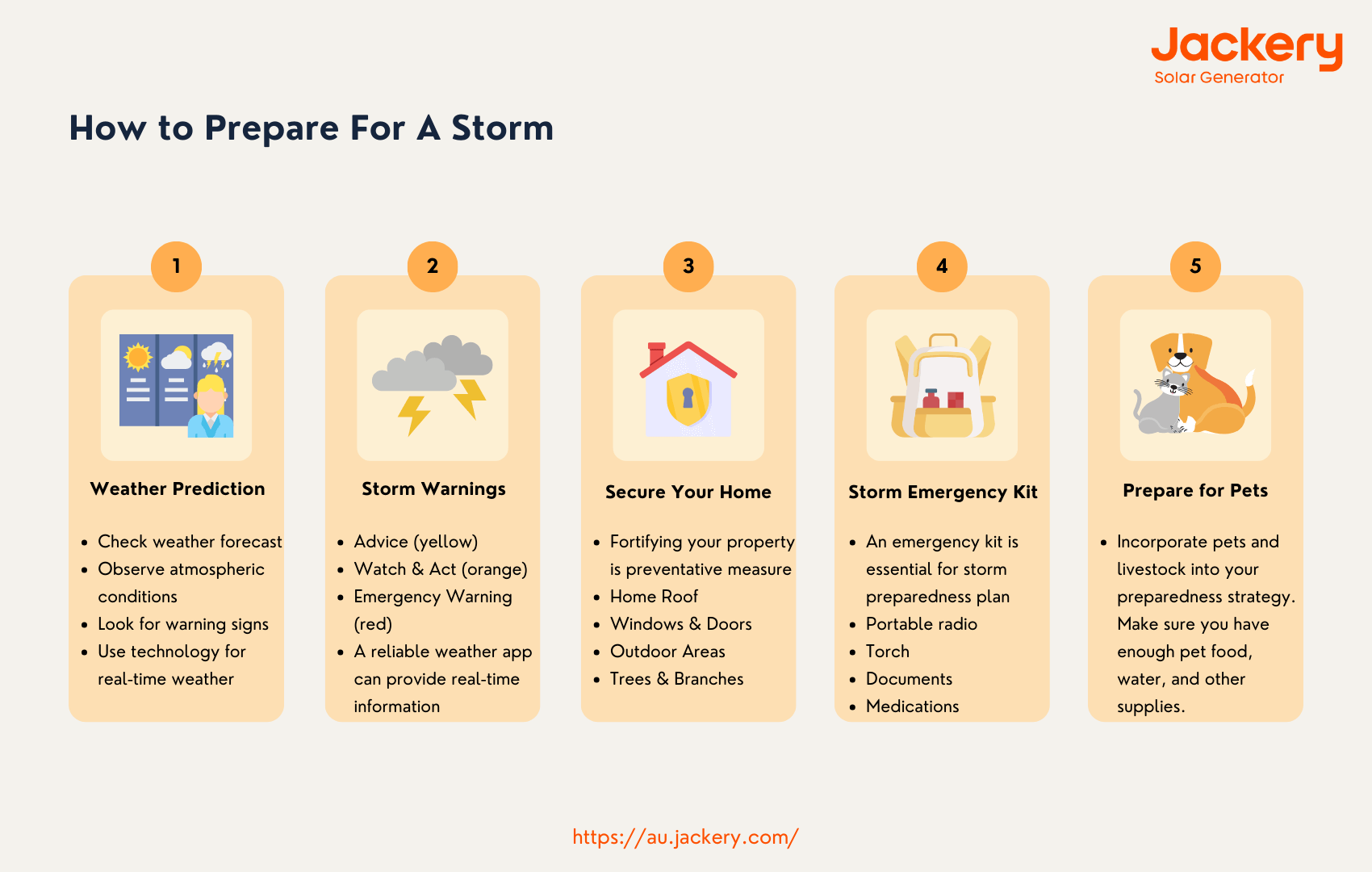
Residents in storm-prone areas must go beyond immediate storm preparations and consider long-term solutions to avoid post-storm damage. This includes fortifying structures to withstand prolonged lousy weather, devising contingency plans for more extended power outages, and ensuring a consistent supply of essential supplies. Recognising and preparing for the long-term effects of storms in Melbourne allows communities to reduce risks and build resilience to atmospheric disturbances.
Step 1: Predict The Melbourne Storms
Predicting when the Melbourne storm will start takes multiple steps:
- Monitor Weather Forecasts: Check for updates from credible meteorological services, such as the Bureau of Meteorology (BOM), which gives detailed forecasts for Melbourne and the surrounding areas.
- Observe Atmospheric Conditions: Monitor atmospheric conditions for rapid changes in temperature, humidity, and wind patterns, which might indicate storm development.
- Look for Warning Signs: Darkening skies, increased wind, and temperature dips might all suggest an impending storm.
- Use Technology: Use technology to access real-time weather data and forecasts for your location.
Step 2: Understand Storm Warnings
Staying informed about impending storms is crucial. Subscribe to local weather alerts and warnings to get timely information. Pay attention to official statements from meteorological and emergency authorities. Understand the different warning levels and respond appropriately when notified. A reliable weather app for your phone can provide real-time information, helping you to stay ahead of changing conditions.

The BOM produces a variety of alerts, including severe thunderstorms, cyclones, and flood warnings. Understanding the distinction between these warnings is critical, as each includes unique recommendations and preventive measures. For example, a severe thunderstorm warning may advise on anticipated hail, heavy rain, and lightning. In contrast, a cyclone warning focuses on strong winds and heavy rainfall over a more extended period.
Step 3: Secure Your Home
Fortifying your property is a preventative measure that can help reduce storm damage. Examine your roof, windows, and doors for flaws. Reinforce weak areas and consider employing impact-resistant materials. There are various places to notice:
- Home Roof
- Windows & Doors
- Outdoor Areas
- Trees & Branches
Your house's roof is one of the first lines of defence against a storm. Ensure it is in good condition, with no loose tiles or shingles. Gutters should be clear of debris to avoid water buildup and potential damage to your home. Regular maintenance of the roof and gutters can lessen the likelihood of storm damage.
Furthermore, windows and doors are susceptible areas during a storm. Consider reinforcing them so they may resist heavy winds. Installing shutters can offer excellent protection. Alternatively, having plywood on hand to board windows is a realistic solution in a strong storm. Also, look for any gaps or cracks around windows and doors and seal them to keep water out.
Outdoor locations frequently contain items that can become harmful projectiles in high winds. Protect or store outside furniture, gardening tools, and other loose goods. Cover your swimming pool to prevent debris pollution.
During a storm, overhanging trees and branches present a severe risk. They can break and fall on your home, inflicting significant damage. To reduce this risk, trim trees and branches regularly, particularly those close to your home.
Step 4: Prepare An Emergency Kit
An emergency kit is essential for every storm preparedness plan. It should include at least three days' worth of water (about three gallons per person), non-perishable food, a first-aid kit, a flashlight with extra batteries, a battery-powered or hand-crank radio for updates, and necessary prescriptions. Check and update this kit regularly to ensure that all elements are working correctly and have not expired.
Protecting your vital documents is critical. Keep copies of your identification documents, insurance policies, bank account information, and other essential data in a waterproof container. This procedure can significantly reduce stress and confusion in the aftermath of a storm. The Melbourne storm emergency kit includes the following items:
|
Melbourne Storm Emergency Kit |
||
|
Portable Radio |
Torch |
First Aid Kit |
|
Candles and waterproof matches |
Essential papers, including emergency contact numbers |
Copy of any Home Emergency Plans |
|
Waterproof bag for valuables |
A good supply of required medications |
Any special requirements and supplies for babies, the disabled, the infirm and the elderly |
|
Appropriate clothing and footwear |
Fresh food |
drinking water |
|
Pet supplies |
Flashlight |
Jackery Solar Generator |
Create a detailed family emergency plan. This plan should include instructions for each family member to contact others, specified meeting spots in the event of separation, and a checklist of steps to take during a storm. Ensure all family members understand and can carry out this strategy if necessary.
Jackery Solar Generators provide a dependable and environmentally responsible solution for powering critical electronics during storms or emergencies. Their portability, solar charging capabilities, and diverse power outputs can dramatically improve your ability to stay connected, safe, and prepared in inclement weather.
Step 5: Prepare for Pets
Incorporate pets and livestock into your preparedness strategy. Make sure you have enough pet food, water, and other supplies. Please set up a safe and secure shelter for them, such as your home or a specified spot on your property. If evacuation is necessary, arrange for transportation and accommodations in pet-friendly shelters.
If you want to know more preparation plans for emergencies, we also have the following:
- How to prepare for a bushfire in Australia
- How to prepare for a cyclone in Australia
- How to prepare for Sydney storm
Jackery Solar Generators for Melbourne Storms
Jackery Solar Generators provide dependable and portable power options that might be especially useful during a Melbourne storm or other emergency. These generators use solar energy to offer clean and sustainable electricity, allowing you to charge essential devices and keep critical systems operational when regular power sources are unavailable.

Jackery Solar Generators use lithium-ion battery packs, which may be recharged using Jackery Solar Panels or another charging source. The integrated solar charging capabilities enable users to recharge the battery with solar energy, changing the generator into a self-sufficient power source for outdoor activities or emergency backup power.
Jackery Portable Power Stations offer several power output options, including AC outlets, DC connectors, and USB ports, for charging electronics and powering domestic appliances. These devices are lightweight and portable, making them suitable for emergencies, especially Solar Generator 1000 Pro and 500.
|
|
Jackery Solar Generator 1000 Pro |
Jackery Solar Generator 500 |
|
Capacity |
1002Wh (43.2V/23.2Ah) |
518Wh (21.6V/24Ah) |
|
Life Cycle |
1000 cycles to 80%+ capacity |
800 cycles to 80%+ capacity |
|
Battery Cell |
NMC battery |
NMC battery |
|
Dimension |
25.5x26.2x34cm |
24.2x19.3x30cm |
|
Recharging Methods |
Explorer 2000 Pro + 2*SolarSaga 80W: 9H; AC Adapter: 1.8H; 12V Car Adapter: 12H |
Explorer 500 + SolarSaga 100W: 9.5H; AC Adapter: 7.5H; 12V Car Adapter: 7.5H |
|
Output Ports |
2*AC Output: 230V, 1000W (peak 2000W); 2*USB-A: Quick Charge 3.0x2, 18W Max; 2*USB-C: 100W Max, (5V, 9V, 12V, 15V, 20V up to 5A); 1*Carport: 12V⎓10A |
1*AC Output: 240V, 500W (peak 1000W); 1*DC Output: 12V⎓7A; 3*USB-A: 5V⎓2.4A; 1*Carport: 12V⎓10A |
Jackery Solar Generator 1000 Pro
The Jackery Solar Generator 1000 Pro is a sophisticated power solution designed with technology and efficiency at its core. This generator demonstrates adaptability and versatility by providing rapid AC recharge in just 1.8 hours, guaranteeing you never go without power when needed. This generator's excellent 1002Wh capacity and powerful 1000W output that can peak at 2000W easily accommodate your power-hungry gadgets and appliances.
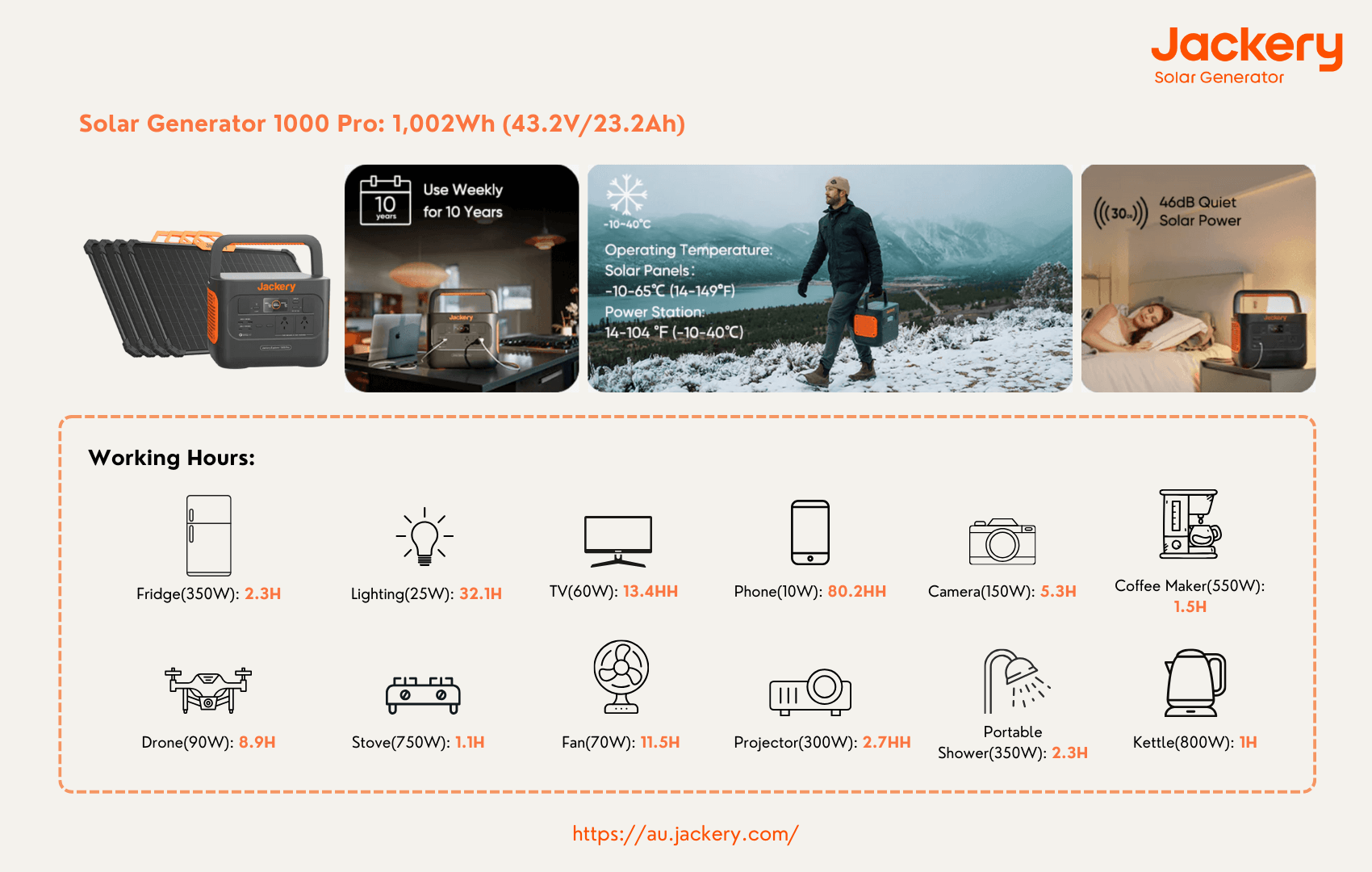
It's built to last a decade, even with weekly use, making it a dependable long-term partner. Fast charging is now possible because of its twin 100W PD fast charging feature. If you need to swiftly charge your flashlights, smartphones, or other PD-compatible devices, the Jackery Solar Generator 1000 Pro covers you. Finally, the Jackery Solar Generator 1000 Pro emphasises flexibility. It provides three handy ways to recharge: solar energy, an AC outlet, and a vehicular output. This ensures you can keep the generator ready to operate regardless of location or circumstances.
Jackery Solar Generator 500
Introducing the Jackery Solar Generator 500, a power solution that perfectly combines mobility and functionality. This generator has an outstanding 518Wh capacity and a dependable 500W inverter capable of peaking at a powerful 1000W surge. It is meant to keep your devices charged whenever and wherever you need them.

The Jackery Explorer 500 portable power station's capacity to charge numerous appliances simultaneously is a notable feature. This generator can power your portable radios during a Melbourne storm and keep your food fresh in the cooler, making it suitable for various applications. With its lightweight and portable design, this sleek generator raises the bar for ease. Whether on an exciting camping trip or having a power outage at home, its compact size makes it simple to transport and set up wherever power is needed.
The Jackery Solar Generator 500 provides three different charging options and a consistent power supply. You choose how you recharge based on your conditions and environment, whether using solar energy, an AC outlet, or automotive output. The Jackery Solar Generator 500 is quiet yet substantial, with a noise level of 37.9 decibels. This makes it an ideal companion in nature, keeping your electronics charged without disrupting the peace of your surroundings.
What Should You Do During A Melbourne Storm?
During a Melbourne storm, it is crucial to prioritise safety and take appropriate measures to protect yourself and your loved ones.
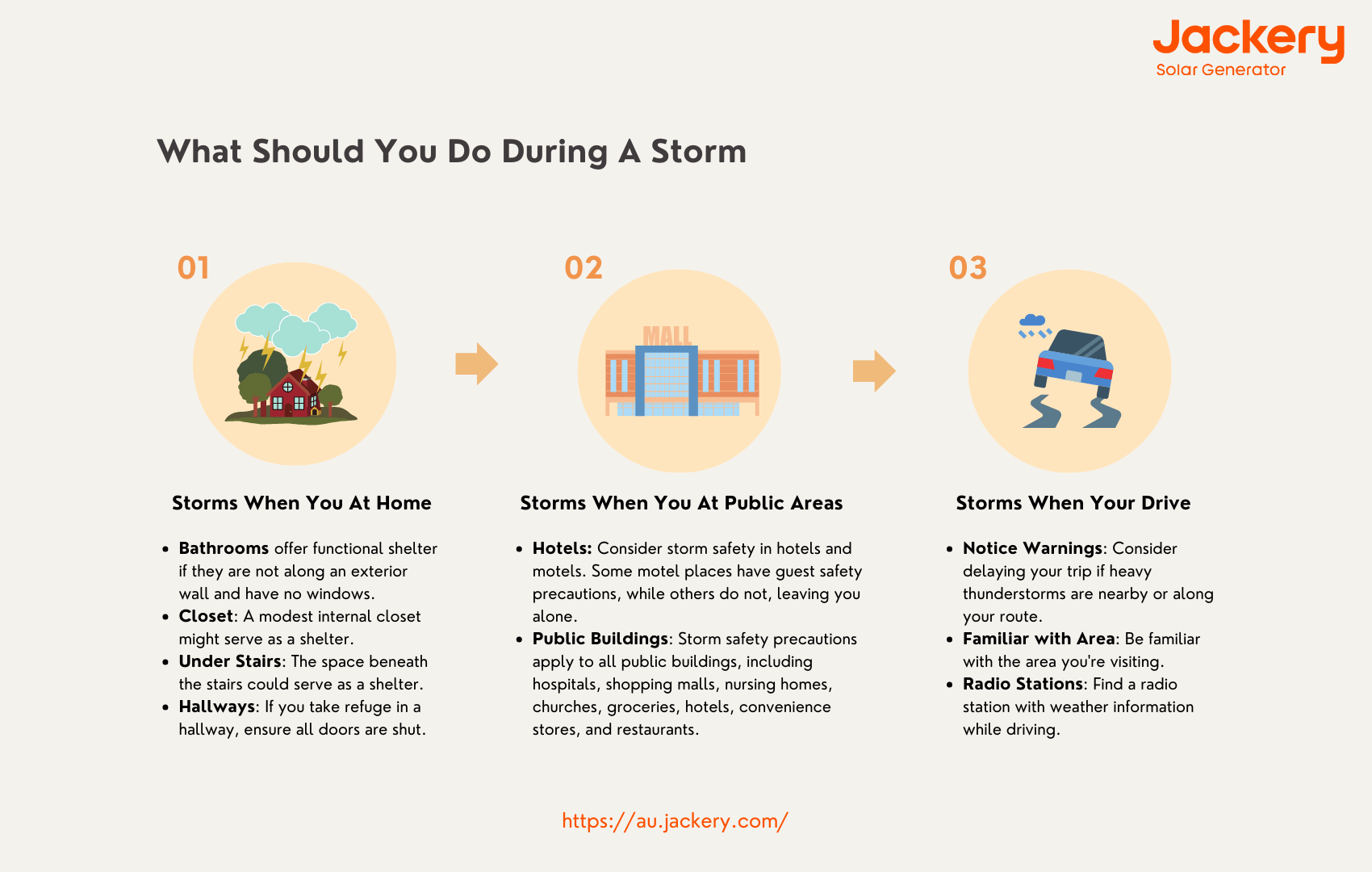
Step 1: Storms When You At Home
During a storm, staying indoors is the safest option. Stay inside your home or seek cover in designated safe zones until the storm passes. Avoid going outside unless necessary. Continue to follow the storm's progress by listening to local news programmes or utilising weather apps on your mobile device. Pay attention to any updates or cautions from authoritative sources. Being fully underground is the finest location to be during a storm. Make good use of your underground storm cellar. Make sure the door is securely fastened.
What should you do if you do not have a safe room, cellar, or underground storm shelter? Remembering the basics of storm safety, you should look at your home to select the ideal location:
- Bathrooms: Bathrooms offer functional shelter if they are not along an exterior wall and have no windows. Contrary to popular opinion, getting into a bathtub with a mattress is not inherently safe. In some circumstances, this could be an excellent refuge.
- Closet: A modest internal closet might serve as a shelter. The closet should be as deep into the structure as possible, with no exterior walls, doors, or windows. Make sure you close the door and cover-up.
- Under Stairs: The space beneath the stairs could serve as a shelter.
- Hallways: If you take refuge in a hallway, ensure all doors are shut. The idea is to place as many obstacles as possible between you and the flying debris in and around a tornado. To be an efficient refuge, a corridor should be as far inside the structure as feasible, with no entrances to the outside.
Step 2: Storms When You At Public Areas
A complete home storm protection plan will only be helpful if you are away from home when a tornado approaches. Consider what you would do if a tornado struck you while you were away from home - at work, church, school, shopping, dining out, on vacation, or participating in outdoor activities.
When you're away from home, you're more exposed to unfamiliar surroundings and the desire for familiar weather information. Business owners and safety managers should plan for tornadoes to ensure the safety of employees, renters, and visitors in public buildings. During a Melbourne storm, you can choose from the following locations:
- Hotels: Consider storm safety in hotels and motels. Some motel places have guest safety precautions, while others do not, leaving you alone. Some restaurants urge that guests seek shelter in the passageways. However, avoiding open halls with doors and windows on each end is advisable.
- Public Buildings: Storm safety precautions apply to all public buildings, including hospitals, shopping malls, nursing homes, churches, groceries, hotels, convenience stores, and restaurants.
Step 3: Storms When Your Drive
Avoid driving unless there is an absolute emergency. Stormy weather can lead to reduced visibility, flooded roads, and fallen trees, making driving difficult. If you must attend, exercise extreme caution and follow any directions from local authorities.
- Notice Warnings: Consider delaying your trip if heavy thunderstorms are nearby or along your route. Then, monitor the news, radio, and internet for updates on storm areas.
- Familiar with Area: Be familiar with the area you're visiting. Keep a highway map on hand that shows county names and boundaries. The NWS issues severe weather warnings based on counties. Not knowing your country can prevent you from receiving vital information.
- Radio Stations: Find a radio station with weather information while driving. Some radio stations will interrupt their programming to broadcast warnings and other information. Others are automated stations, but they might not be. Look for a station that delivers local weather updates and listen for specifics. A battery-operated weather radio is essential for tourists. Remember that you will not receive any warnings if you listen to CDs or satellite radio in your car.
What Should You Do After A Dust Storm in Australia?
After a Melbourne storm, act cautiously and take the required precautions to guarantee safety and recovery.
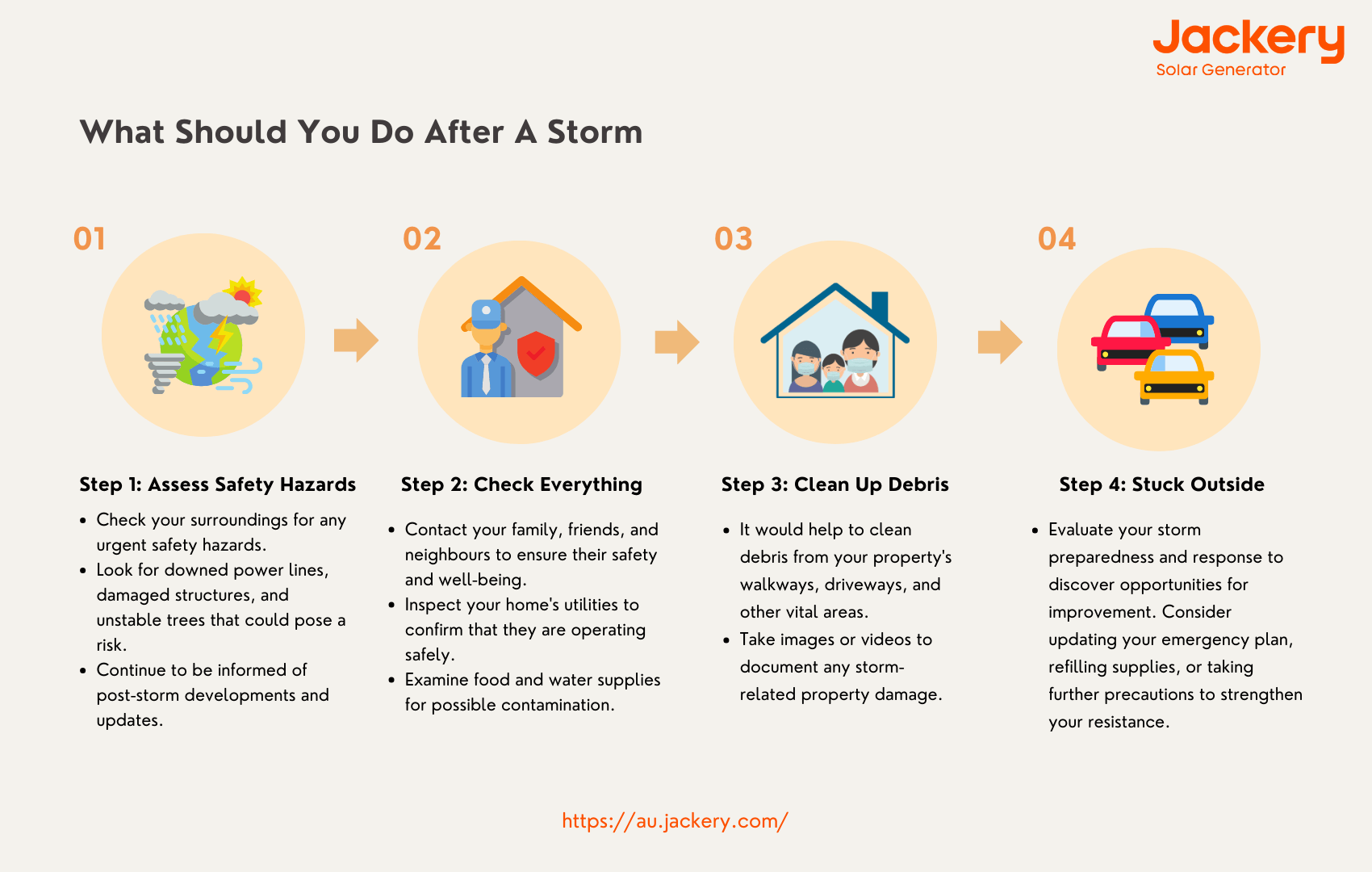
Step 1: Assess Safety Hazards
Before you go outside:
- Check your surroundings for any urgent safety hazards.
- Look for downed power lines, damaged structures, and unstable trees that could pose a risk. If you see any possible threats, remain safe and notify the proper authorities.
- Continue to be informed of post-storm developments and updates.
- Contact local news stations and radio broadcasts or visit reputable websites for accurate information on road conditions, utility restoration, emergency services, and community assistance efforts.
Step 2: Check Everything
Contact your family, friends, and neighbours to ensure their safety and well-being. If you encounter someone in trouble or need medical attention, offer assistance or notify the police. Prioritise screening vulnerable people, such as older people, small children, and those with impairments.
Inspect your home's utilities to confirm that they are operating safely. If you suspect gas, water, or electrical damage, immediately turn off the primary sources and contact utility agencies for professional help. Only attempt to restore utilities if you are certified.
Examine food and water supplies for possible contamination. Things that could spoil owing to power outages or lack of refrigeration should be thrown out. If tap water is unsafe, use bottled water or boil it before drinking until officials affirm its safety.
Step 3: Clean Up Debris
It would help to clean debris from your property's walkways, driveways, and other vital areas. Use caution when handling fallen branches or other large debris because they may be unstable or entangled with electrical lines. Wear adequate protection gear, such as gloves and sturdy footwear.
Take images or videos to document any storm-related property damage. These documents will be required when filing insurance claims and requesting aid from relief agencies. Remember to photograph structure damage, flooded regions, fallen trees, and other essential facts.
Step 4: Learn From Experience
Evaluate your storm preparedness and response to discover opportunities for improvement. Consider updating your emergency plan, refilling supplies, or taking further precautions to strengthen your resistance to future weather catastrophes. If you have any information that would help others be better prepared, please share it with them.
Final Thoughts
Storms, a natural phenomenon marked by substantial alterations in atmospheric conditions, can frequently cause anxiety and uncertainty. Preparedness is essential in a storm-prone area like Australia. Understanding Melbourne storms, from their formation to their potential effects, can help people reduce risks and stay safe. Equipping oneself with emergency supplies like Jackery Solar Generators, which provide continuous power for your home throughout a storm, can significantly help control the situation.



















































